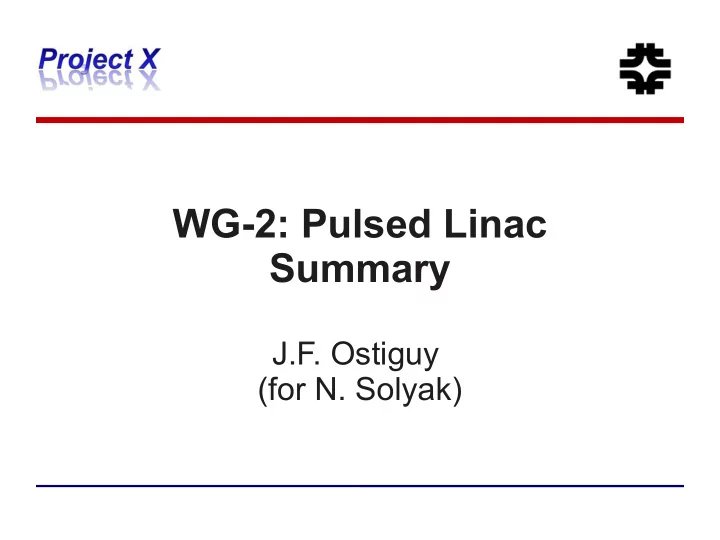

WG-2: Pulsed Linac Summary J.F. Ostiguy (for N. Solyak)
P a g General e 2 • One session, Tue 15:00-17:30, 15-20 participants • Eight presentations, 3 main topics - status and general plans for FY 2012 - transfer lines - LL and HL RF challenges, experimental results and modeling • The pulsed linac is still at the conceptual level – Modest manpower & resources for FY12 – Many issues in common with ILC, XFEL, SPL, ESS, SNS etc … Much interest in communications and exchanges with these groups.
Overview (N.Solyak) N. Solyak Focusing : FODO Lattice; each quad has x/y correctors and BPM Cavity: Average Gradient 25 MV/m; max spread ±10% Q0=10 10; Qload=1 ∙ 107 (Note: Q L for a matched cavity at 25MV, Ib=1mA is 2.5∙107 => BW1/2 =26Hz, too small to deal with LFD and microphonics) Filling time = 4 ms, flat-top = 4.3 ms RF source: Pulse length = 8.3 ms; Rep. rate = 10 Hz 0.4 (0.8) MW klystron per 1(2) CM’s (5o kW/cav with ~60% overhead) H- beam: Current = 1 (2) mA; (10 mA peak @ 162.5 MHz)- Energy 3GeV; emittance~ 0.25 mm*mrad; σ E/E=0.5MeV(init), < 10 MeV (exit) - Synchronous phase -10 °
Splitable Quadrupole Concept For Pulsed Linac (N. Solyak) V. Kashikin Magnet was developed for ILC, but in principle is ready for use in PX pulsed linac. Can be simplified in view of more modest requirements for PX PL (max gradient (4 vs 54 T/m), magnetic center stability etc)
Splittable Quadrupole Prototype At 90 A the quadrupole reached the specified peak gradient 54 T/m.
Summary of Preliminary Studies for 3-8 GeV Linac (N. Solyak) LLRF control - Static simulations for scheme with 1 klystron per 2 CM - With VS control at the level below~0.5 % and 0.5 deg (individual cavity error ~10% and 10 deg) allow keep energy jitter at 8 GeV below 10 MeV. (needed for injection) - Dynamics simulations with LFD/microphonics and Acc. gradient spread underway (see presentations: G.Cancello, B.Chase, Y .Eidelman) Beam losses are smaller than for CW linac - Intra-beam stripping is well below 0.1 W/m - Magnetic stripping is small for reasonable beam displacement (<20mm)
FY2012 R&D Plan (N. Solyak) Complete lattice design and specifications for misalignments and RF tolerances (N.Solyak) Beam dynamics, losses, system specifications Failure analysis Long-pulse operation stability requirements Concept Design of the beam collimation system and Radiation issues, Specs Develop specs for linac components Review modified ILC like CM design (cavity, coupler,magnets,cryo) as a baseline for pulse linac Design of the transport lines to and from pulsed linac, functional specs (D.Johnson) Develop conceptual design of the HLRF system (modulators, klystrons, PDS, controls) – J.Reid Define baseline configuration and alternatives based on requirements and cost analysis Write specifications and cost estimations for HLRF system LLRF performances study and development of specifications for long pulse operation regime (B.Chase) Develop LLRF control system for cavity, operating in long-pulse regime, based on multiple tests of ILC like cavities in HTS and NML cryomodule Develop models and software for long-pulse operations with LLRF controls Develop specifications and costing of LLRF system. Complete conceptual and EM design of splittable SC magnet (V.Kashikhin) Conceptual design of the cryogenic systems and specifications (A.Klebaner) Create specifications for beam diagnostics in Linac and transport lines (M.Wendt) TOTAL= 4.3 FTEs
Pulsed Linac Transfer Lines (D. Johnson)
CW Linac to Pulsed Linac (D. Johnson) “Fairly straightforward; should be no issues - Don't foresee the need for collimation or Cold beam tube.”
8 GeV Transport (D. Johnson) Details of design change according to – which ring we inject into – Operational scenarios (i.e, maximum beam intensity) • Full 10 Hz operation (2.7E14 particles/sec) for 345 kW • Just 6 linac pulses for 120 GeV neutrino program (170 kW) – Elevation of transport line and the requirement for vertical achromat Proton Driver and Project X Initial Configuration contained an 8 GeV beam dump line – needs re-evaluation • Injection and transport line design will ultimately determine the footprint of the Project X facility
HLRF Parameters (J.Reid)
Klystron Parameters (J. Reid)
Power Distribution Schemes How many Cavities/ Klystron ? (J. Reid)
LLRF Requirements (B. Chase)
Experimental Results NML CM1 Feedback + Piezo Detuning Compensation (B. Chase) Feedback OFF Feedback ON
Microphonic Detuning for 7 Cavities 1000 second period, 1 Hz rep rate Cavity 1 does not have active detuning compensation (control case)
Detuning and Fill Time
Dynamic Simulations with LLRF Stabilization: 20% gradient spread, LFD, u-phonics, beam and coupler errors (G. Cancelo) • 1st RF station is DESY-FLASH ACC6-7 • All other 12 RF stations have 2 low gradient cavities at 18MV and 14 cavities at 26MV. • Simulation assumptions: LFD: ~ 60 Hz at 25 MV. • µ-phonics: ±5Hz uniformly distributed. • Beam errors: • Coupler error: 10% uniformly distributed. •
SCREAMm : Improved version of SCREAM ( Y.Eidelman et al.) Main new features: More realistic expression for the vector-sum; Friendly GUI; More realistic modeling of Lorentz detuning
Concerns for 3-8 GeV Pulsed Linac
Lorentz Detuning Model ( Y.Eidelman et al.)
LFD Model Based on N-mode Fit Experimental Data: LFD Measurements Short pulse: τ = µ 500 s , fill τ = µ 80 0 s flat Simulation of LFD taking into account increasing number of the eigenmodes
LFD Model Based on N-mode Fit Experimental Data: LFD Measurements Short pulse: τ = µ 500 s , fill τ = µ 80 0 s flat Simulation of LFD taking into account increasing number of the eigenmodes
FNAL Adaptive LFD (Y . Pischalnikov)
LFD Compensation Test
Final Remarks ● 3-8 Pulsed linac RF control is challenging given the long pulse length and low beam loading. ● Effective LFD compensation is essential ● RF Power distribution scheme needs to be optimized, taking into account the need to operate with cavity (10- 20% ?) gradient spread. (cavities/klystron ?) ● Optics design is relatively straightforward at high energy and appears under control although many details still need to be finalized.
Recommend
More recommend